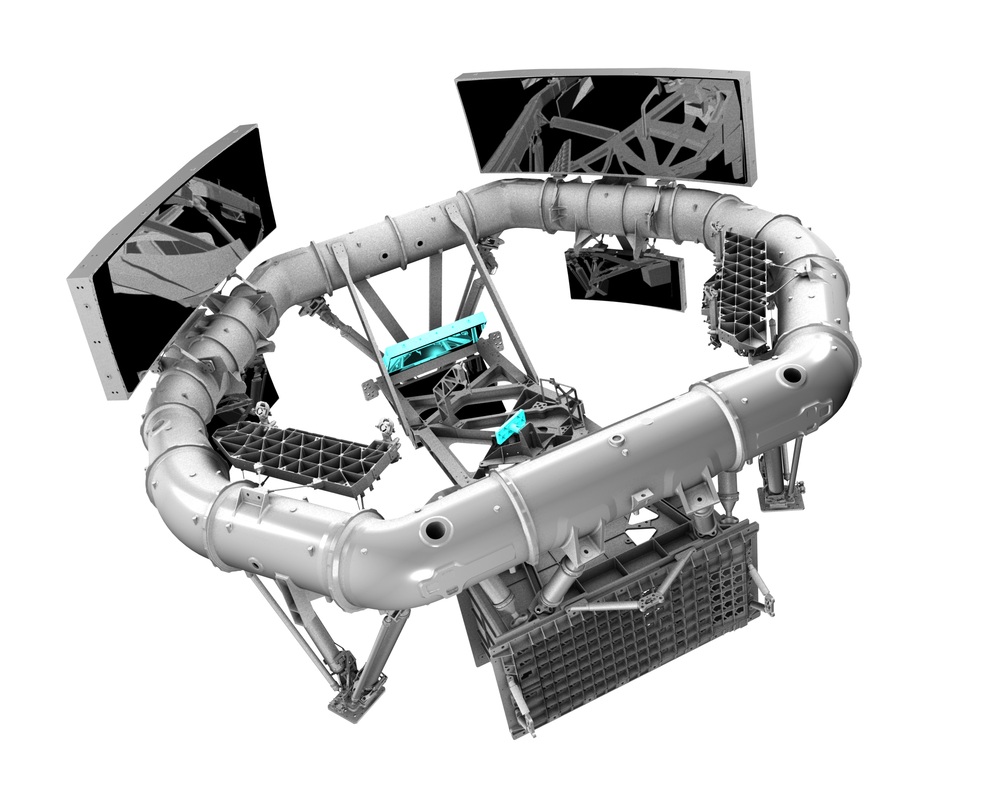
above: GAIA's Silicon Carbide Optical Bench, with the two objective mirrors of it's twin telescopes pointing 106.5° apart. From Spaceflight 101, image credit: ESA/Astrium.
Cool GIF that is too big to put here: http://i.giphy.com/l2Sq1WUTZeWNXaoEM.gif
In order to make extremely precise measurements of positions throughout the sky, GAIA slowly spins and reads out the CCD images in a synchronized fashion - the image on the CCD moves at the same rate as the charge is transferred and read out (clocked) from pixel to pixel. This allows field distortion effects within one telescope to be constantly measured and compensated, since most stars will be measured up to 70 different times passing through a different height (perpendicular to scan direction) across the CCDs multiple times.
The multiple measurements as GAIA follows Earth's motion around the sun allows for high precision parallax determination, which can be used to calculate a distance for a very large number of stars in a systematic way.
However, the necessary kind of precision over long separations in the sky would be extremely difficult with a single telescope. The "trick" that GAIA uses is to have both telescopes project on to same CCD array at the same time! A star will pass across the CCD array twice, first accompanied by stars that are 106.5° ahead of it and the second time accompanied by stars that are 106.5° behind it. This allows the analysis to build up precise relationships at simultaneously very wide and very narrow separations.


both above: GAIA's CCD array, from Spaceflight 101, image credit: ESA and Astrium respectively.
According to the GAIA FAQs which does an excellent job: http://www.cosmos.esa.int/web/gaia/faqs:
Why does GAIA have two telescopes?
The goal of the Gaia mission is to perform global astrometry over the entire celestial sphere. For this purpose, the satellite is equipped with two telescopes whose viewing directions are separated by a large, so-called basic angle (106.5 deg). This allows to make simultaneous measurements of star positions at small and large angular scales, i.e., inside each telescope field of view and between the two fields of view. Since the parallax factor differs between the two fields of view, global astrometry can be performed (as compared to relative astrometry offered by a single field of view). Wide-angle measurements also guarantee a distortion-free and rigid system of coordinates and proper motions over the whole sky.
and
Why is there an angle of 106.5 degrees between Gaia's 2 telescopes?
The choice of the so-called basic angle of GAIA was a non-trivial one. On the one hand, it should be of order 90 degrees to allow simultaneous measurements of stars separated by large angles on the sky. On the other hand, it should not be a harmonic ratio of a 360-degree circle (e.g., 60 deg, 90 deg, or 120 deg). Taking these considerations into account, acceptable ranges for the basic angle are 96.8 +/- 0.1 deg, 99.4 +/- 0.1 deg, 100.5 +/- 0.1 deg, 105.3 +/- 0.1 deg, 106.5 +/- 0.1 deg, 109.3 +/- 0.1 deg, 109.9 +/- 0.1 deg, etc. Accommodation aspects identified during industrial studies subsequently favoured 106.5 deg as the value finally adopted for Gaia.
and
How do you ensure the stability of the basic angle?
The stability of the basic angle is achieved through the design of the spacecraft and mission (profile), including the choice of material for most payload structural parts (silicon-carbide), the absence of moving parts in the spacecraft (except for the thruster valves), the thermo-mechanical decoupling between the service and payload modules, a constant power dissipation of the payload, and the spacecraft orbit and attitude (ensuring a constant solar illumination without eclipses by the Earth). In addition, the basic-angle monitor provides continuous feedback on short-term basic-angle variations (P < 12 h), with long-term variations (P > 12 h) being calibrated within the data processing.


